Abstract
1. In cats under ether or hexobarbitone anaesthesia the auriculotemporal nerve was cut near the parotid gland on one side and 12-20 mm more proximally on the other. After 22-64½ hr the cats were anaesthetized with chloralose and the parotid ducts cannulated. Degeneration secretion of saliva which appears after post-ganglionic parasympathetic denervation was found to start 2-5½ hr later in the gland denervated proximally than in that denervated distally. It ceased, on the other hand, later in the former than in the latter gland.
2. Before degeneration secretion had started spontaneously it could be provoked by intravenous injection of acetylcholine, methacholine, carbachol or eserine and the effect was more pronounced on the gland denervated distally. When it had ceased spontaneously it could also be provoked, and the effect on the other gland was now more marked.
3. Earlier it has been assumed that while a nerve is degenerating there is a period when the nerve endings are unable to retain in a normal way acetylcholine still being synthesized. It is now suggested that this period starts later after proximal than after distal denervation because more of the material required for the normal function of the endings is available in a long piece than in a short piece of nerve.
Full text
PDF
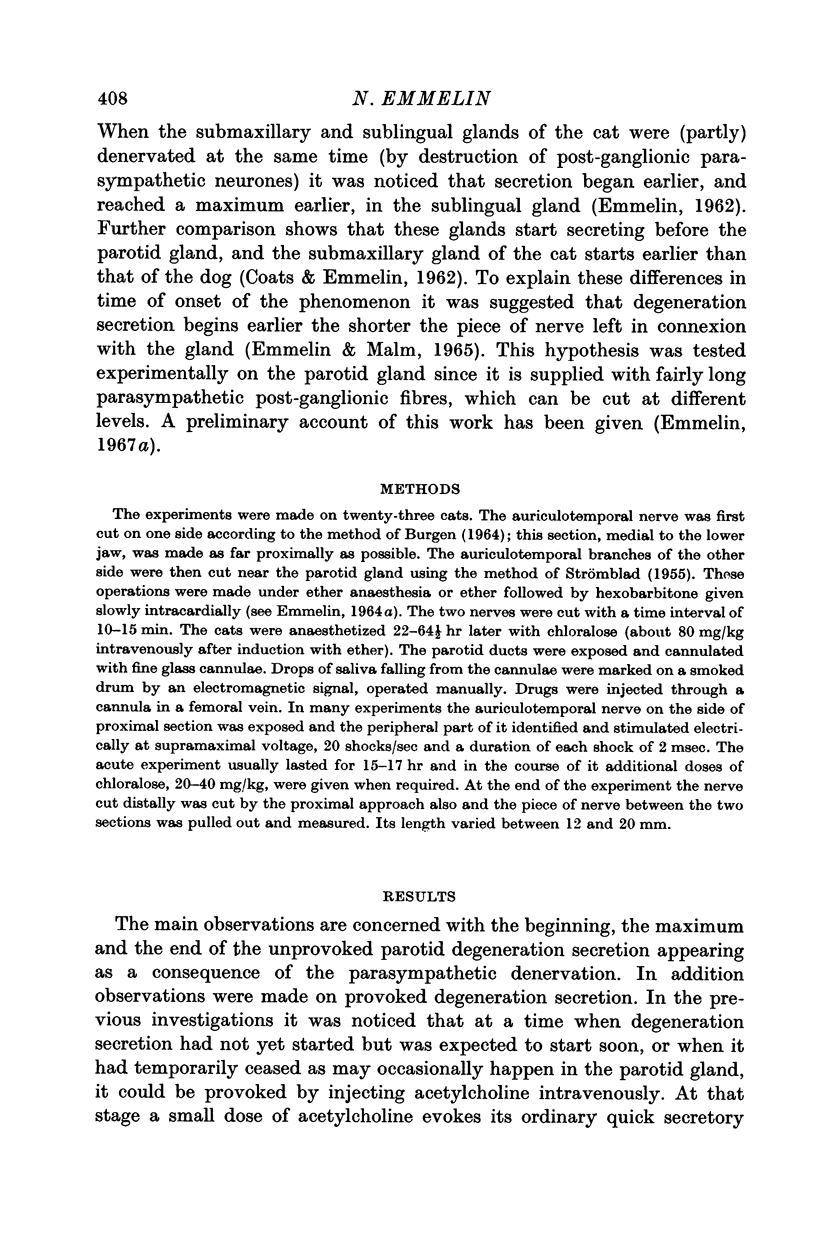
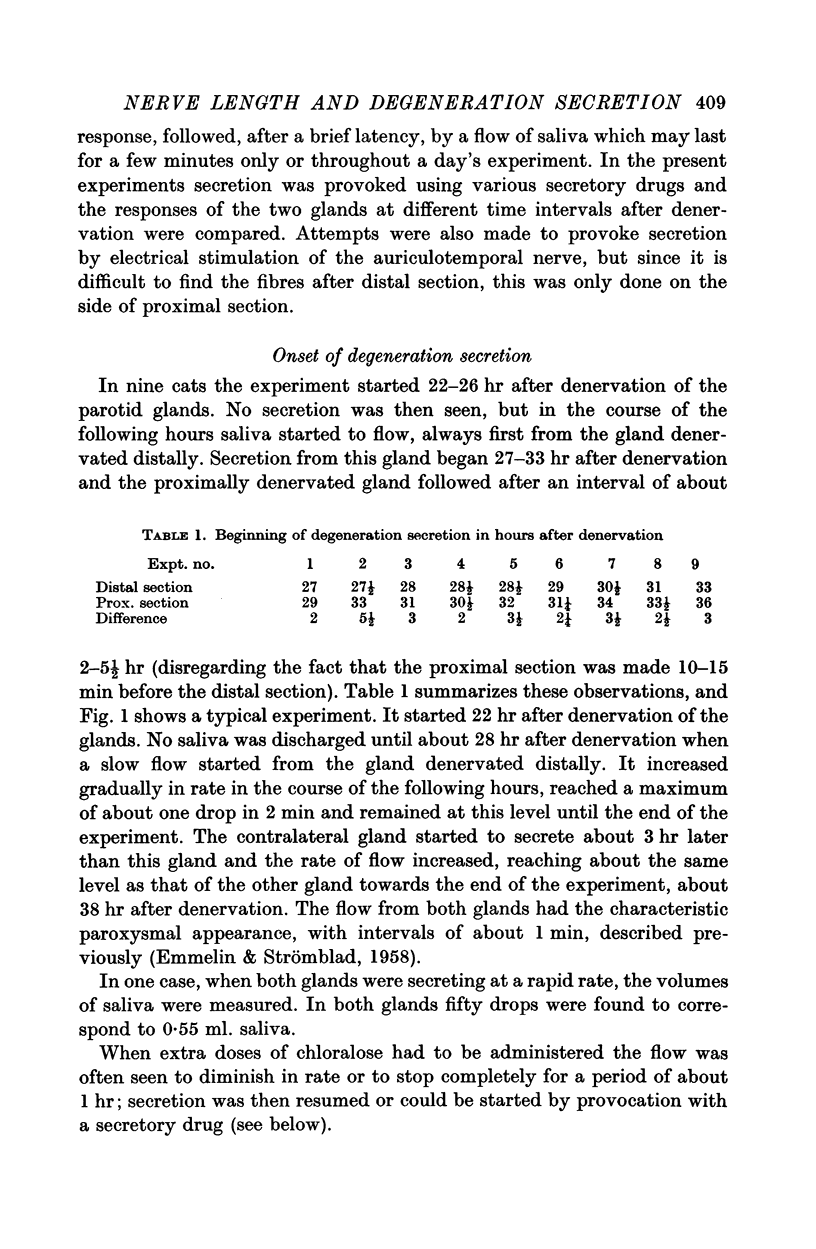
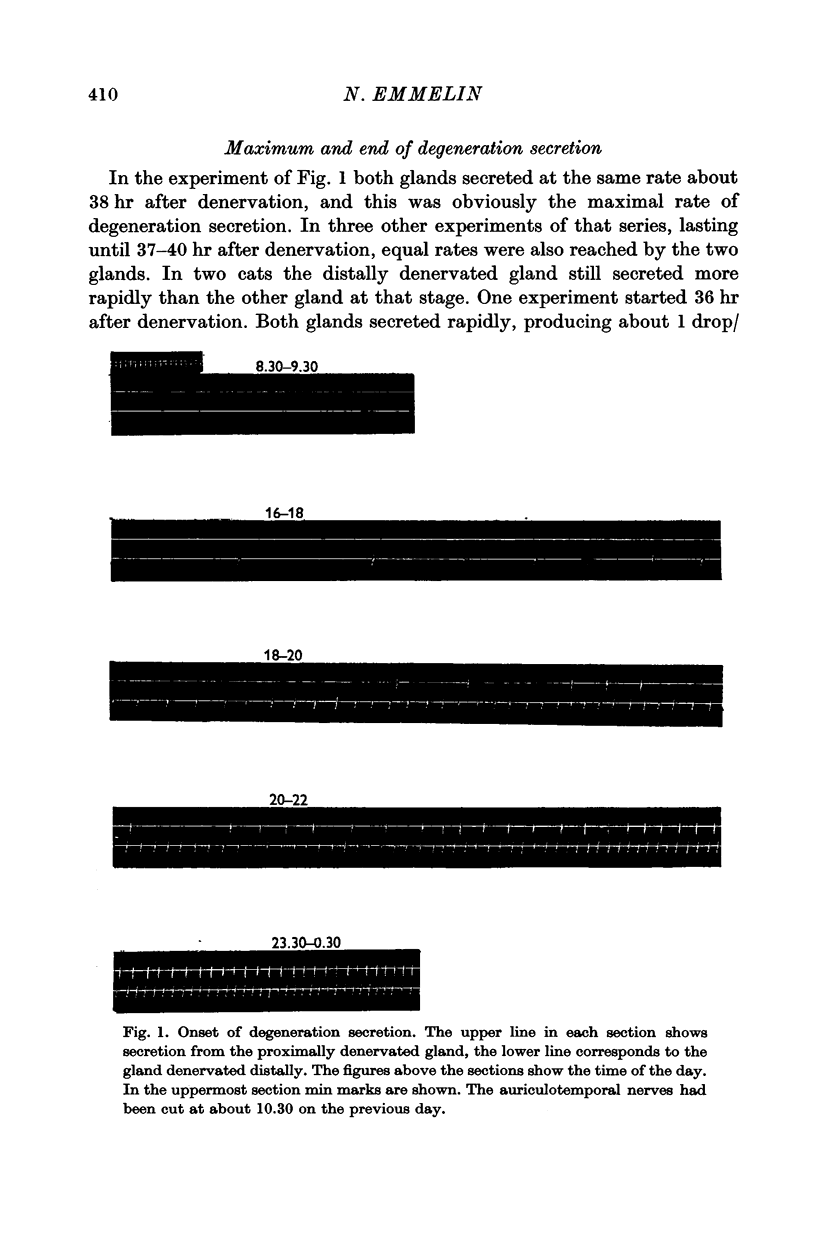
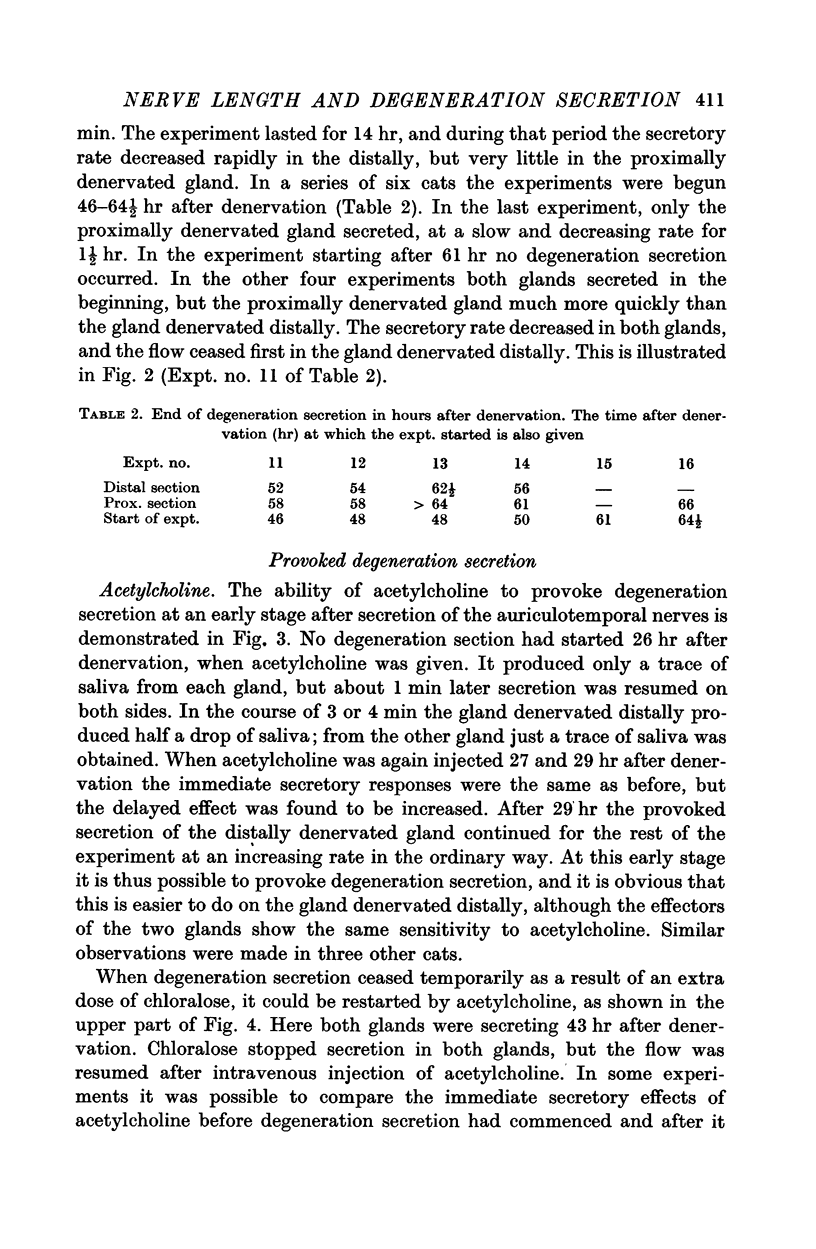
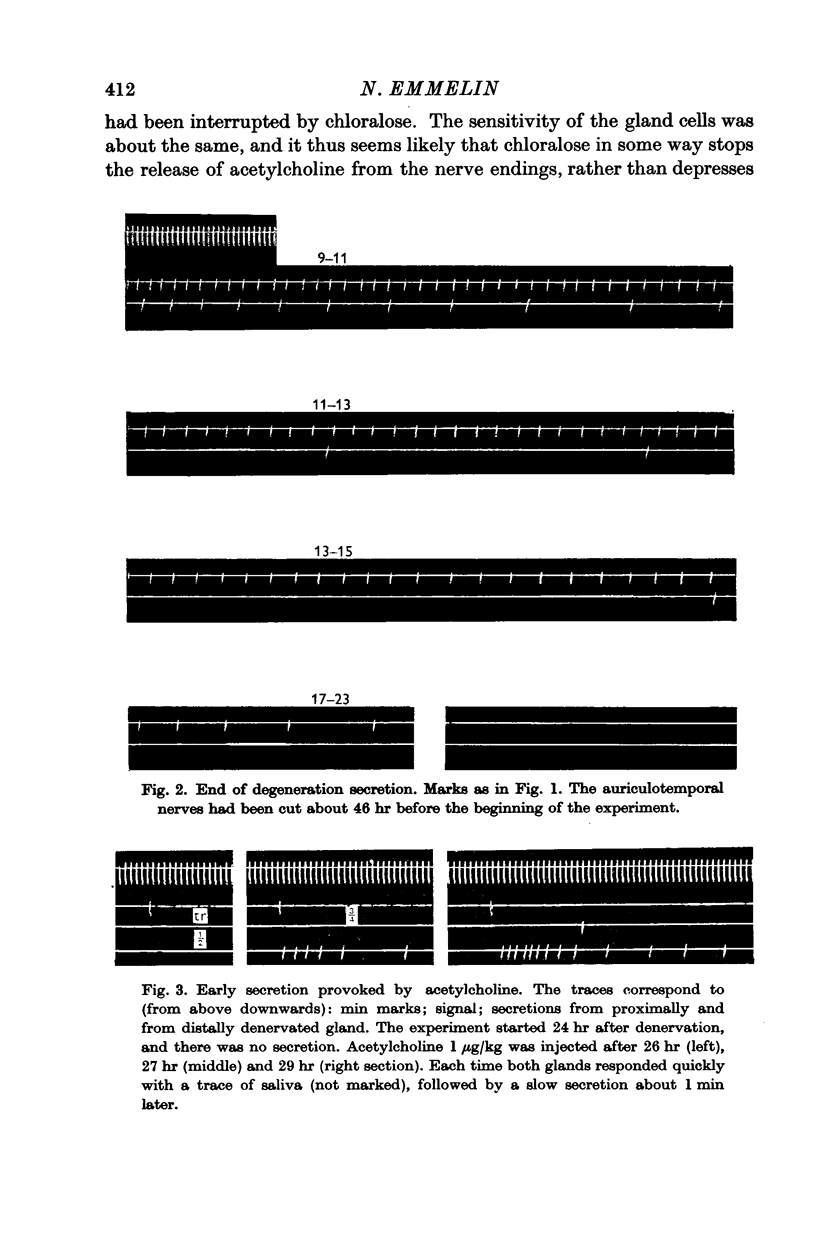
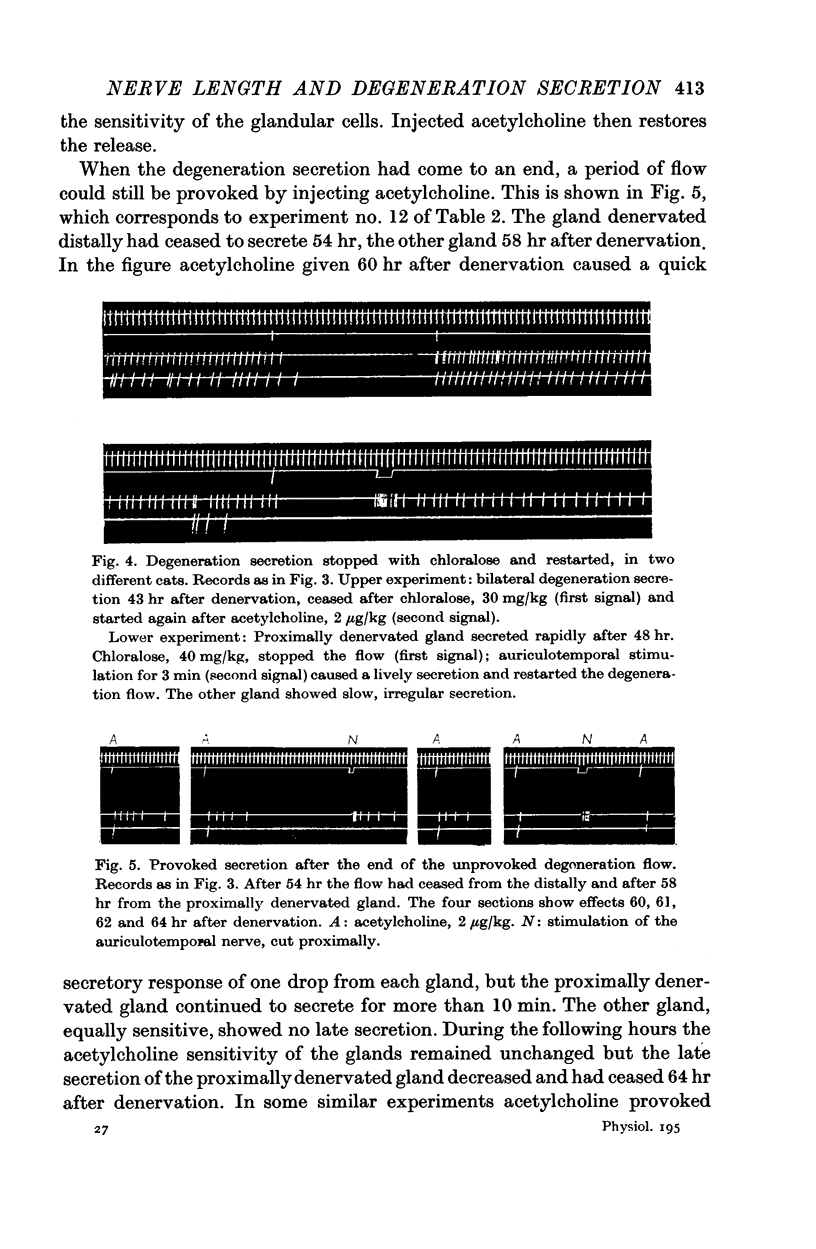
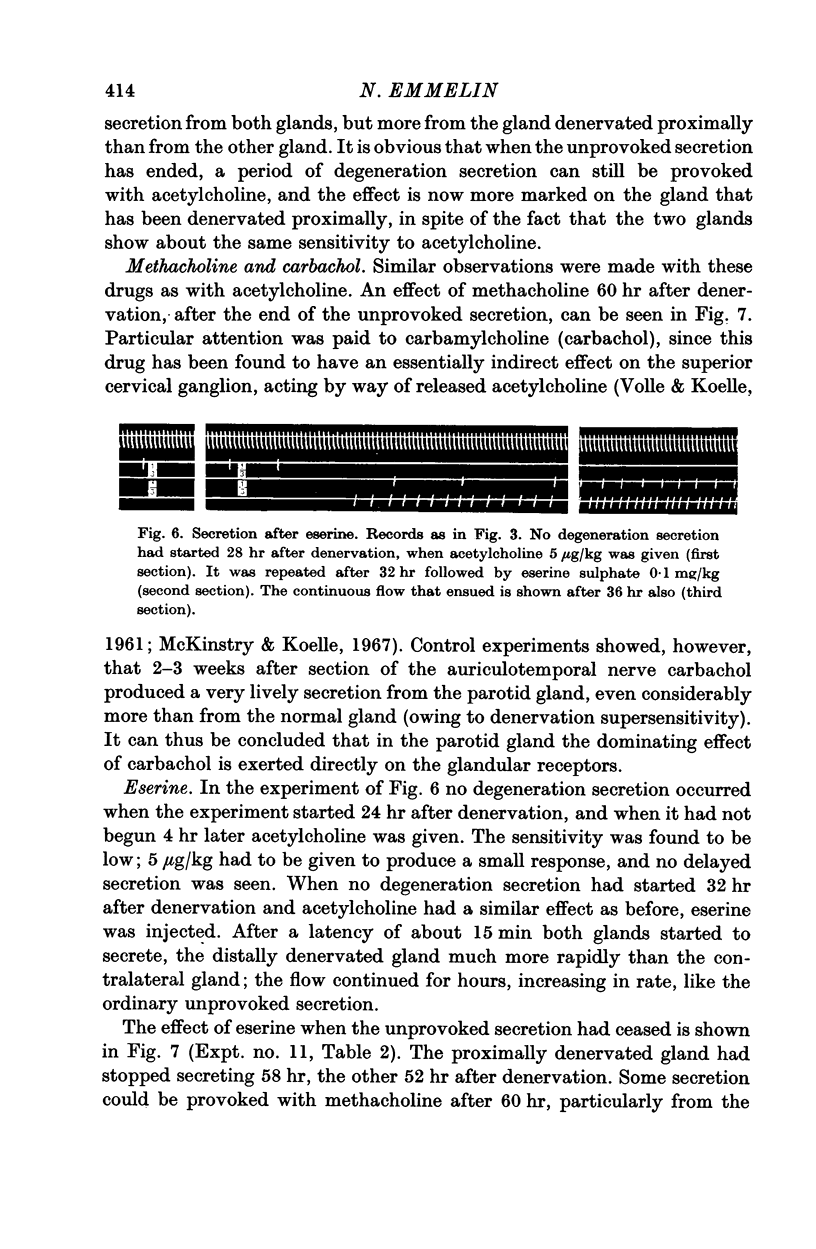
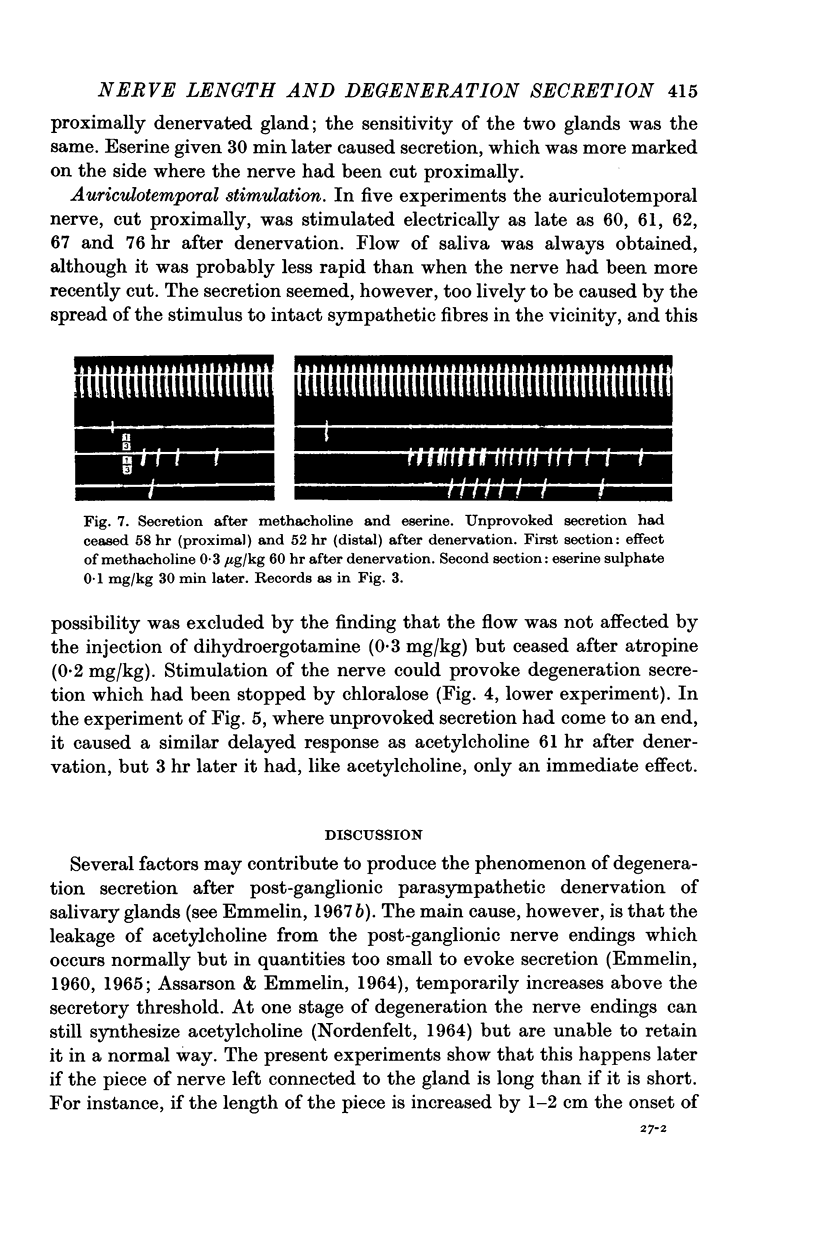
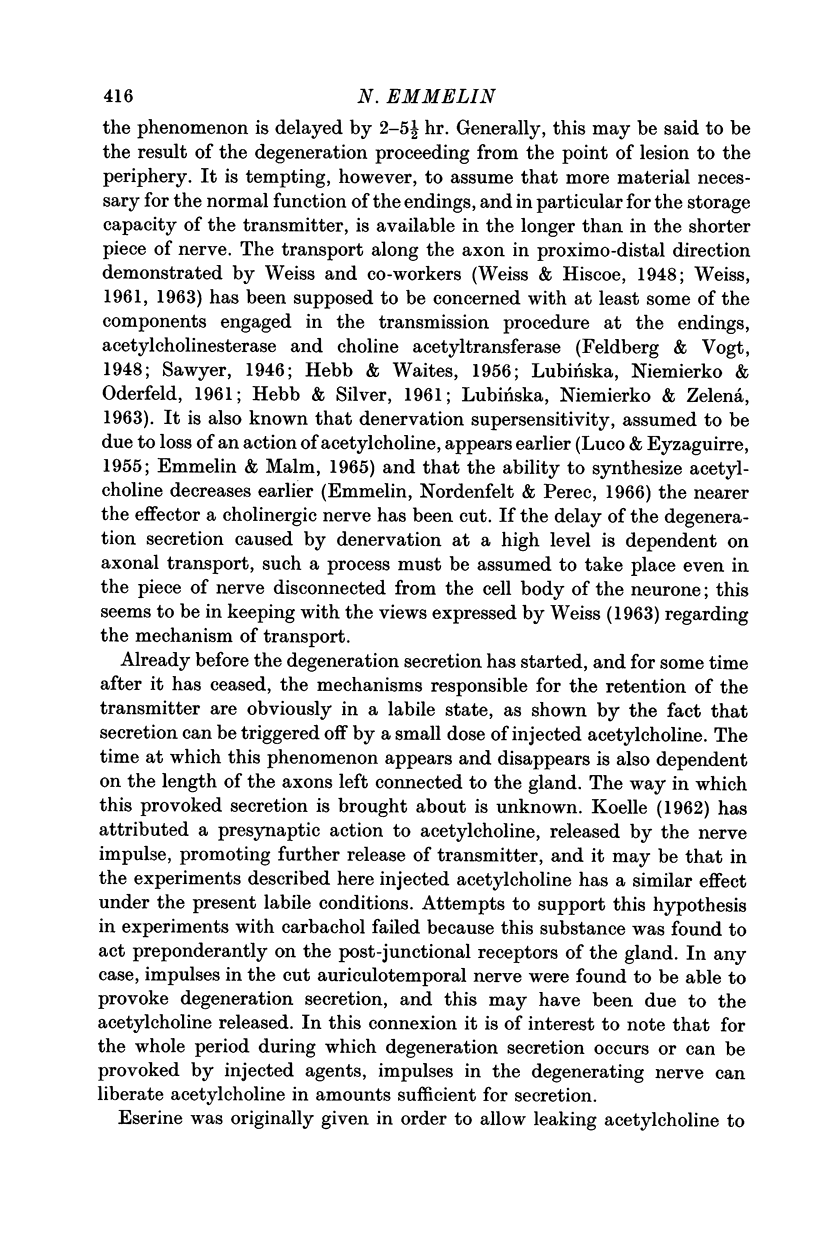
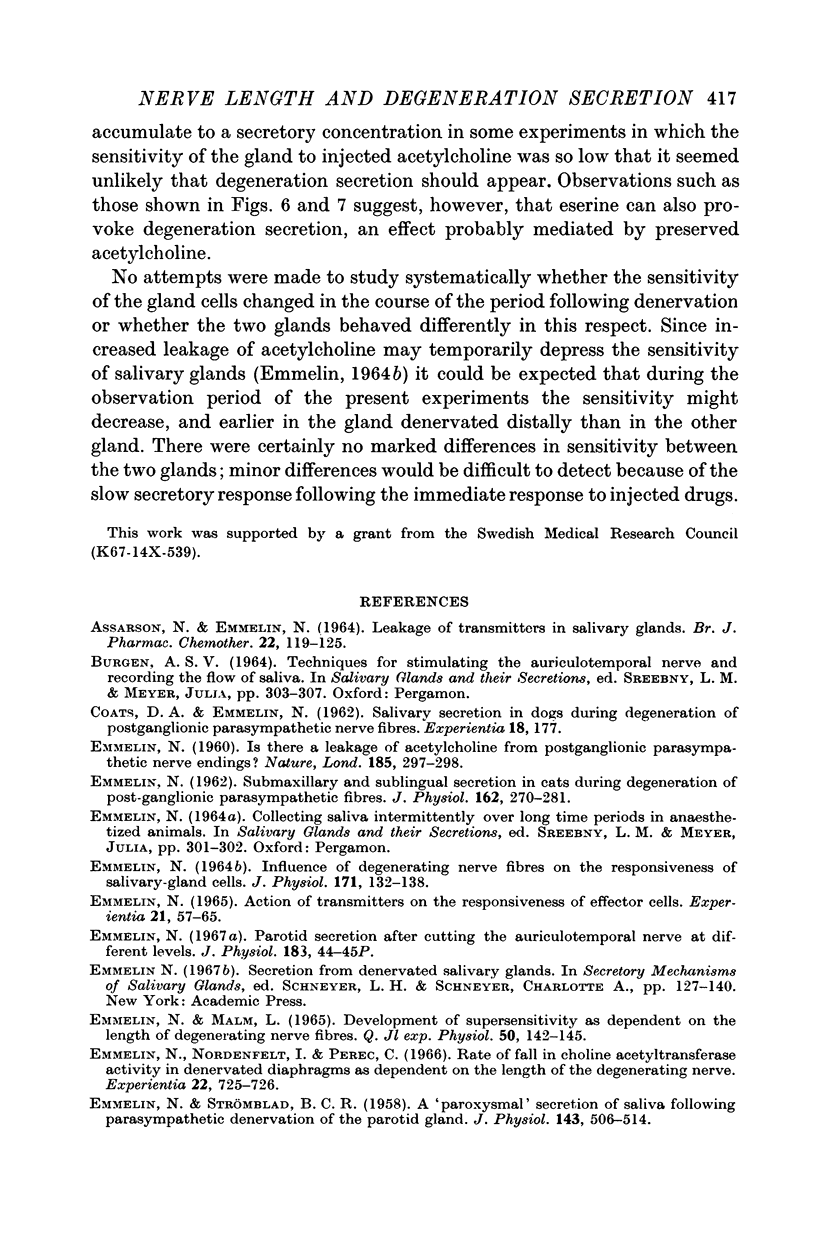
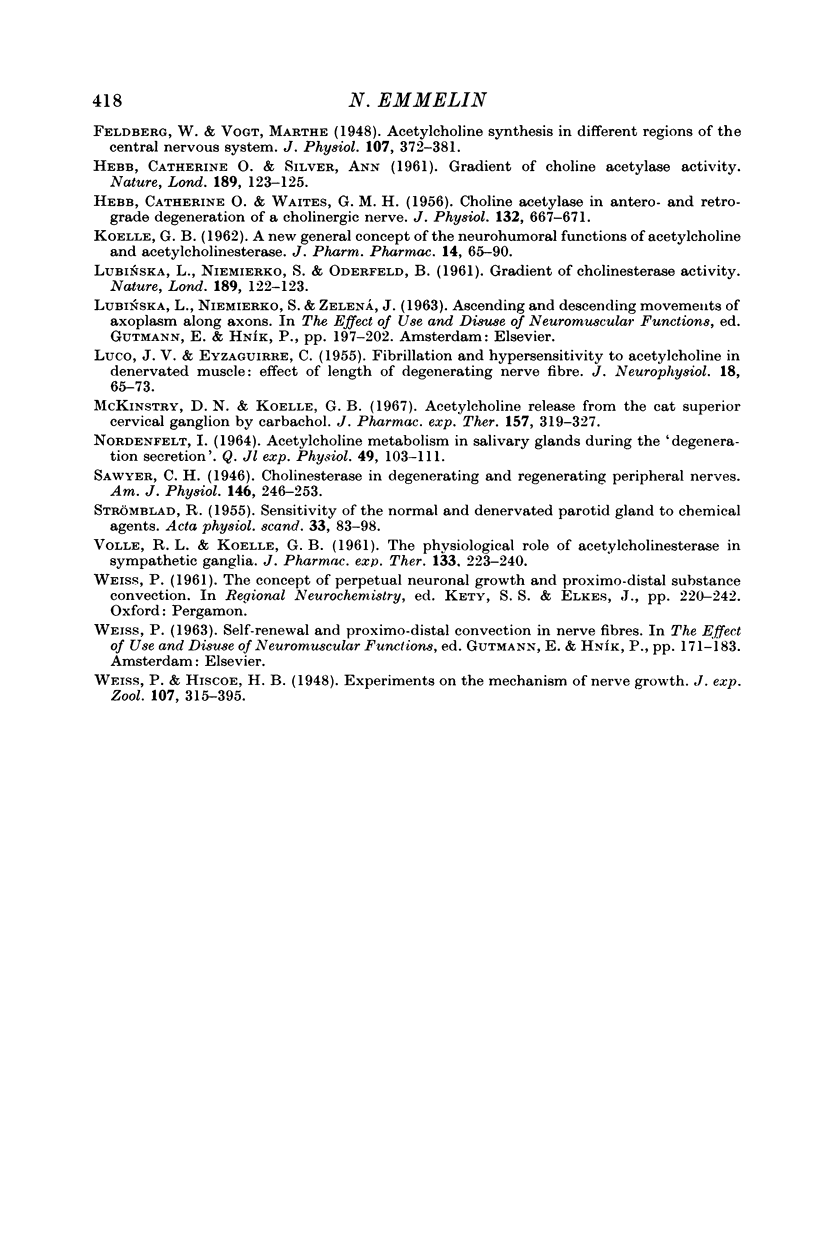
Selected References
These references are in PubMed. This may not be the complete list of references from this article.
- ASSARSON N., EMMELIN N. LEAKAGE OF TRANSMITTERS IN SALIVARY GLANDS. Br J Pharmacol Chemother. 1964 Feb;22:119–125. doi: 10.1111/j.1476-5381.1964.tb01549.x. [DOI] [PMC free article] [PubMed] [Google Scholar]
- BURGEN A. S. TECHNIQUES FOR STIMULATING THE AURICULO-TEMPORAL NERVE AND RECORDING THE FLOW OF SALIVA. Int Ser Monogr Oral Biol. 1964;3:303–307. doi: 10.1016/b978-1-4832-2871-6.50026-6. [DOI] [PubMed] [Google Scholar]
- COATS D. A., EMMELIN N. Salivary secretion in dogs during degeneration of postganglionic parasympathetic nerve fibres. Experientia. 1962 Apr 15;18:177–177. doi: 10.1007/BF02151714. [DOI] [PubMed] [Google Scholar]
- EMMELIN N. ACTION OF TRANSMITTERS ON THE RESPONSIVENESS OF EFFECTOR CELLS. Experientia. 1965 Feb 15;21:57–65. doi: 10.1007/BF02144740. [DOI] [PubMed] [Google Scholar]
- EMMELIN N. INFLUENCE OF DEGENERATING NERVE FIBRES ON THE RESPONSIVENESS OF SALIVARY-GLAND CELLS. J Physiol. 1964 May;171:132–138. doi: 10.1113/jphysiol.1964.sp007367. [DOI] [PMC free article] [PubMed] [Google Scholar]
- EMMELIN N. Is there a leakage of acetylcholine from post-ganglionic parasympathetic nerve endings? Nature. 1960 Jan 30;185:297–298. doi: 10.1038/185297a0. [DOI] [PubMed] [Google Scholar]
- EMMELIN N., MALM L. DEVELOPMENT OF SUPERSENSITIVITY AS DEPENDENT ON THE LENGTH OF DEGENERATING NERVE FIBRES. Q J Exp Physiol Cogn Med Sci. 1965 Apr;50:142–145. doi: 10.1113/expphysiol.1965.sp001776. [DOI] [PubMed] [Google Scholar]
- EMMELIN N., STROMBLAD B. C. A paroxysmal secretion of saliva following parasympathetic denervation of the parotid gland. J Physiol. 1958 Oct 31;143(3):506–514. doi: 10.1113/jphysiol.1958.sp006074. [DOI] [PMC free article] [PubMed] [Google Scholar]
- EMMELIN N. Submaxillary and sublingual secretion in cats during degeneration of post-ganglionic parasympathetic fibres. J Physiol. 1962 Jul;162:270–281. doi: 10.1113/jphysiol.1962.sp006931. [DOI] [PMC free article] [PubMed] [Google Scholar]
- Feldberg W., Vogt M. Acetylcholine synthesis in different regions of the central nervous system. J Physiol. 1948 Jun 25;107(3):372–381. doi: 10.1113/jphysiol.1948.sp004282. [DOI] [PMC free article] [PubMed] [Google Scholar]
- HEBB C. O., SILVER A. Gradient of choline acetylase activity. Nature. 1961 Jan 14;189:123–125. doi: 10.1038/189123a0. [DOI] [PubMed] [Google Scholar]
- HEBB C. O., WAITES G. M. Choline acetylase in antero- and retro-grade degeneration of a cholinergic nerve. J Physiol. 1956 Jun 28;132(3):667–671. doi: 10.1113/jphysiol.1956.sp005556. [DOI] [PMC free article] [PubMed] [Google Scholar]
- KOELLE G. B. A new general concept of the neurohumoral functions of acetylcholine and acetylcholinesterase. J Pharm Pharmacol. 1962 Feb;14:65–90. doi: 10.1111/j.2042-7158.1962.tb11057.x. [DOI] [PubMed] [Google Scholar]
- LUBINSKA L., NIEMIERKO S., OBERFELD B. Gradient of cholinesterase activity. Nature. 1961 Jan 14;189:122–123. doi: 10.1038/189122a0. [DOI] [PubMed] [Google Scholar]
- LUCO J. V., EYZAGUIRRE C. Fibrillation and hypersensitivity to ACh in denervated muscle: effect of length of degenerating nerve fibers. J Neurophysiol. 1955 Jan;18(1):65–73. doi: 10.1152/jn.1955.18.1.65. [DOI] [PubMed] [Google Scholar]
- McKinstry D. N., Koelle G. B. Acetylcholine release from the cat superior cervical ganglion by carbachol. J Pharmacol Exp Ther. 1967 Aug;157(2):319–327. [PubMed] [Google Scholar]
- NORDENFELT I. ACETYLCHOLINE METABOLISM IN SALIVARY GLANDS DURING THE "DEGENERATION SECRETION". Q J Exp Physiol Cogn Med Sci. 1964 Jan;49:103–111. doi: 10.1113/expphysiol.1964.sp001696. [DOI] [PubMed] [Google Scholar]
- STROMBLAD R. Sensitivity of the normal and denervated parotid gland to chemical agents. Acta Physiol Scand. 1955 Feb 16;33(1):83–98. doi: 10.1111/j.1748-1716.1955.tb01195.x. [DOI] [PubMed] [Google Scholar]
- VOLLE R. L., KOELLE G. B. The physiological role of acetyl-cholinesterase (AChE) in sympathetic ganglia. J Pharmacol Exp Ther. 1961 Aug;133:223–240. [PubMed] [Google Scholar]


